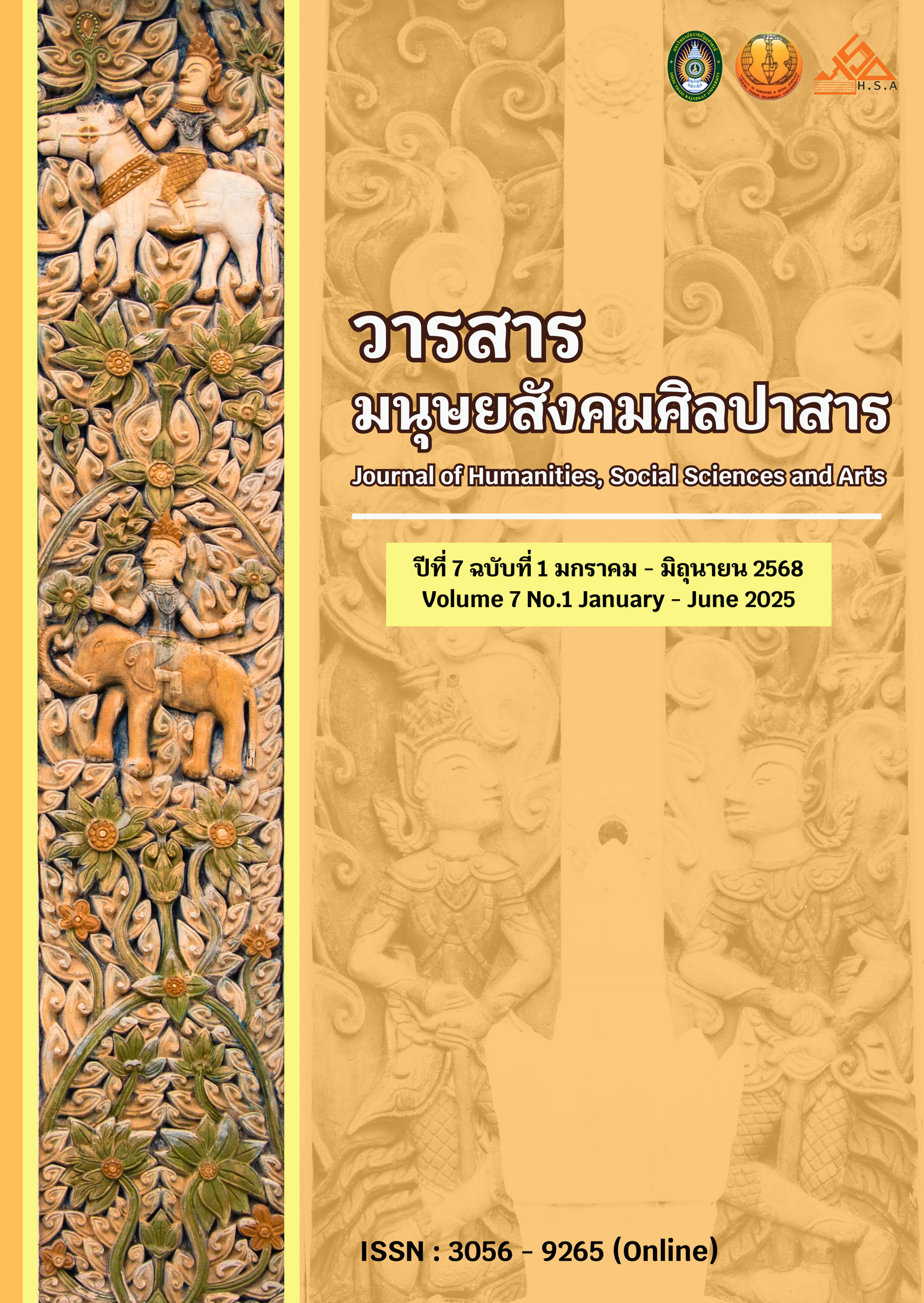THE CREATIVE PERFORMING ARTWORK “TAM TIAN PRATHIP PU CHA PHUTTHA THAM” THROUGH THE STUDY OF THE YI PENG TRADITION OF THE LANNA PEOPLE
Main Article Content
Abstract
The performance art piece "Tam Tian Prathip Pu Cha Phuttha Tham" was created with the aim of 1) studying the history of the Yi Peng tradition, including understanding its unique and distinct identity and the lifestyle context of the Lanna people, and 2) creating a unique local dance titled "Tam Tian Prathip Pu Cha Phuttha Tham." The research findings revealed that the creation of this performance art piece was based on choreographic theory and two key concepts: 1) The concept of history and the formation of Lanna Buddhist cultural identity, the concept developed through studying historical contexts and the process of cultural identity formation focusing on the ancient Lanna traditions, which had preserved and practiced cultural conservation since ancient times, driven by faith and devotion to Buddhism. These traditions had been disseminated to Thailand and other neighboring kingdoms. The insights gained from studying these traditions served as guidelines for the creative process; 2) The concept of thinking, designing, and creating in performing arts which involved studying the forms and techniques of dance performed by solo or multiple performers, examining the processes of formation changes and lineup arrangements, determining music and songs, costumes, scenery, and other crucial components, which were integrated into the creation of performing arts.
Based on the study of related documents and fieldwork conducted with local wisdom teachers, the researchers analyzed and synthesized the gathered data to create the performance art piece titled "Tam Tian Prathip Pu Cha Phuttha Tham." This new creation of Lanna-style dance not only integrated traditional choreography while preserving the unique identity of Lanna dance but also incorporated Dharma principles related to the Yi Peng tradition of Lanna, highlighting the use of traditional Lanna lanterns as a key element in the performance. The performance featured costumes with patterns reflecting the distinct identity of Northern Thailand. The researchers selected music that conveyed the emotions associated with the way of life and the religious practice of Buddhists. Additionally, the incorporation of light from Tang Tham Luang into the lanterns and music signified celebration. Moreover, the procession of dancers in the Yi Peng festival used the Northern Thai dialect to enhance the audience's experience.
Downloads
Article Details
References
เชษฐ์ นิมมาทพัฒน์. (2562). วิถีวัฒนธรรมชาวพุทธกับการสืบสานประเพณีการเทศน์มหาชาติในล้านนา. วารสารพุทธศาสตร์ศึกษา, 10(2), 532-544.
พระครูรัตนชัยธรรม. (2562). หมู่บ้านโคมยี่เป็ง เมืองสาตรหลวง. เชียงใหม่: ณัฐพลการพิมพ์.
พระครูสถิตธรรมาภินันท์. (2561). ศึกษาหลักพระพุทธธรรมที่ปรากฏในประเพณียี่เป็งของล้านนา. [วิทยานิพนธ์พุทธศาสตรมหาบัณฑิต สาขาวิชาพระพุทธศาสนา บัณฑิตวิทยาลัย, มหาวิทยาลัยมหาจุฬาลงกรณราชวิทยาลัย]. ฐานข้อมูลวิจัย (Thailis).
พีรพงศ์ เสนไสย. (2547). นาฏยประดิษฐ์. มหาสารคาม: คณะศิลปกรรมศาสตร์ มหาวิทยาลัยมหาสารคาม
มณี พยอมยงค์. (2547). ประเพณีสิบสองเดือนล้านนาไทย. พิมพ์ครั้งที่ 5. เชียงใหม่: ส.ทรัพย์การพิมพ์.
สงวน โชติสุขรัตน์. (2511). ประเพณีไทย ภาคเหนือ. เชียงใหม่: ส.ทรัพย์การพิมพ์.
อนุกูล โรจนสุขสมบูรณ์. (2549). แนวคิดทฤษฎีการฟ้อนล้านนาแบบใหม่. [วิทยานิพนธ์ศิลปศาสตรดุษฎีบัณฑิต คณะศิลปกรรมศาสตร์ สาขาวิชานาฏยศิลป์ไทย, จุฬาลงกรณ์มหาวิทยาลัย]. ฐานข้อมูลวิจัย (Thailis).
อุดม รุ่งเรืองศรี. (2542). “อานิสงส์ผางประทีส/ประทีป” ใน สารานุกรมวัฒนธรรมไทยภาคเหนือ. กรุงเทพฯ: มูลนิธิสารานุกรมวัฒนธรรมไทย ธนาคารไทยพาณิชย์.

